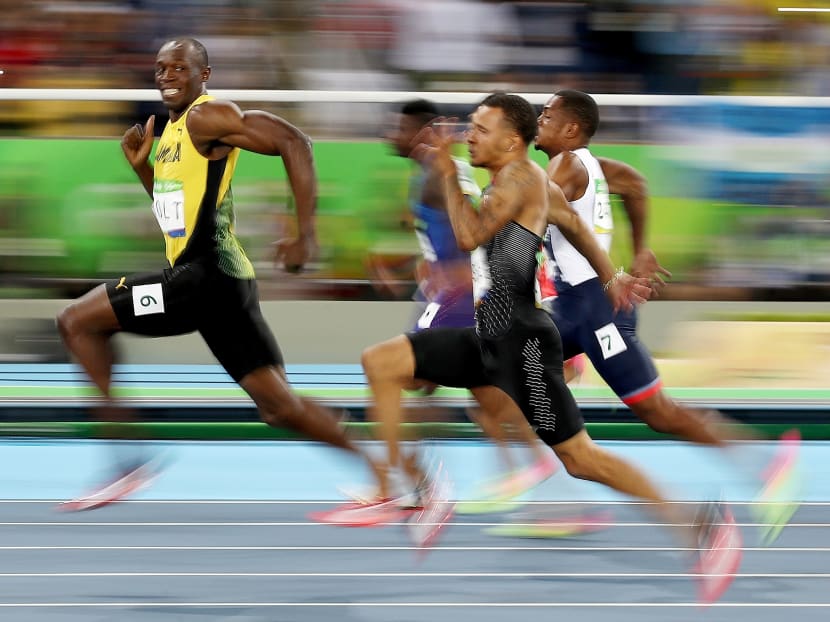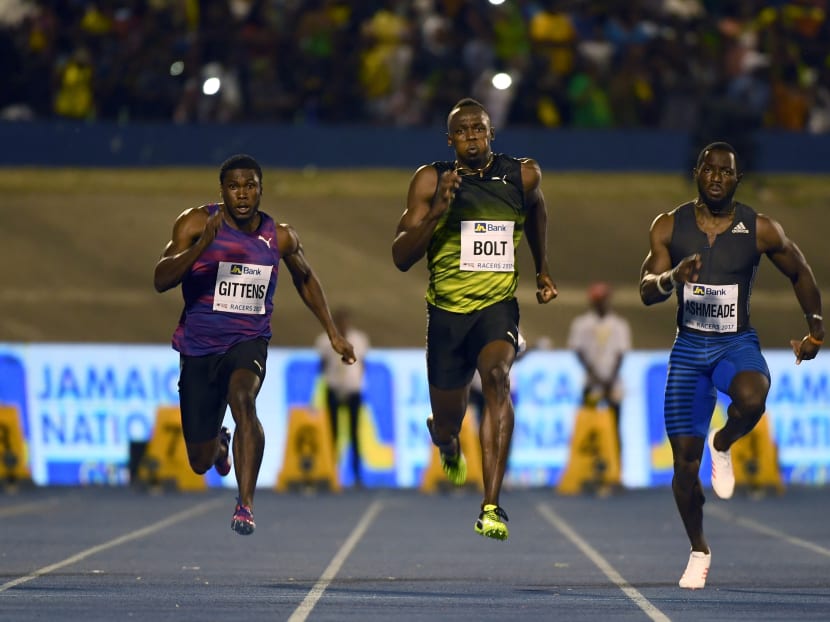There’s something strange in Usain Bolt’s stride - which makes him a champion
DALLAS - Usain Bolt of Jamaica appeared on a video screen in a white singlet and black tights, sprinting in slow motion through the final half of a 100m race. Each stride covered nine feet, his upper body moving up and down almost imperceptibly, his feet striking the track and rising so rapidly that his heels did not touch the ground.

Usain Bolt competing in the men's 100m semi-finals at the Rio Olympics. Research has shown that even though Bolt stands 1.95m, he starts nearly as explosively as smaller sprinters and needs only 41 strides to cover 100m, while other elite runners need 43 or 45 or even 48. Photo: Getty Images
DALLAS - Usain Bolt of Jamaica appeared on a video screen in a white singlet and black tights, sprinting in slow motion through the final half of a 100m race. Each stride covered nine feet, his upper body moving up and down almost imperceptibly, his feet striking the track and rising so rapidly that his heels did not touch the ground.
Bolt is the fastest sprinter in history, the world-record holder at 100 and 200m and the only person to win both events at three Olympics. Yet as he approaches his 31st birthday and retirement this summer, scientists are still trying to fully understand how Bolt achieved his unprecedented speed.
Last month, researchers here at Southern Methodist University, among the leading experts on the biomechanics of sprinting, said they found something unexpected during video examination of Bolt’s stride: His right leg appears to strike the track with about 13 percent more peak force than his left leg.
And with each stride, his left leg remains on the ground about 14 percent longer than his right leg.
This runs counter to conventional wisdom, based on limited science, that an uneven stride tends to slow a runner down.
So the research team at SMU’s Locomotor Performance Laboratory is considering a number of questions as Bolt prepares for what he said would be his final performances at a major international competition - the 100m and 4x100m relay next month at the world track and field championships in London.
Among those questions: Does evenness of stride matter for speed? Did Bolt optimise this irregularity to become the fastest human?
Or, with a more balanced stride during his prime, could he have run even faster than 9.58 seconds at 100m and 19.19 seconds at 200m?
“That’s the million-dollar question,” said Peter Weyand, director of the SMU lab.
The SMU study of Bolt, led by Andrew Udofa, a doctoral researcher, is not yet complete. And the effect of asymmetrical strides on speed is still not well understood.
But rather than being detrimental for Bolt, the consequences of an uneven stride may actually be beneficial, Weyand said.
It could be that Bolt has naturally settled into his stride to accommodate the effects of scoliosis. The condition curved his spine to the right and made his right leg half an inch shorter than his left, according to his autobiography.
Initial findings from the study were presented last month at an international conference on biomechanics in Cologne, Germany. Most elite sprinters have relatively even strides, but not all. The extent of Bolt’s variability appears to be unusual, Weyand said.
“Our working idea is that he’s probably optimised his speed, and that asymmetry reflects that,” Weyand said.
“In other words, correcting his asymmetry would not speed him up and might even slow him down. If he were to run symmetrically, it could be an unnatural gait for him.”
Some background:
Jamaican men and women won 11 of the 18 available medals in the 100 and 200 at the past three Olympics, though the Caribbean island has a population of only 2.8 million. Theories about Jamaican sprinting success have ranged from their proportion of fast-twitch muscle fibers to a renowned youth development system to a public health campaign dating to the 1920s.
At its most basic, speed is the product of stride length times stride frequency. Though Bolt stands 1.95m, he starts nearly as explosively as smaller sprinters and needs only 41 strides to cover 100 meters, while other elite runners need 43 or 45 or even 48.
No sprinter can accelerate for a full 100m. But once Bolt reaches top speed at 60 to 70m, he maintains his velocity more efficiently than others, decelerating less toward the finish line. The winner of a sprint is not the person speeding up the fastest at the end but slowing down the slowest.
It was once widely assumed that the swiftest runners achieved top speed by swinging their legs more rapidly than slow runners while repositioning their limbs between take-off and landing.
In a 2000 study, Weyand, then working with a team at Harvard, determined that elite sprinters did not swing their legs appreciably quicker through the air. Instead, they gained maximum speed by striking the ground with a greater force than others in relation to their body weight, and for a shorter period of time.
For Olympic-calibre sprinters, that peak force can equal five times their body weight, providing lift and propulsion to begin the next stride. In Bolt’s case, his peak force can surpass 1,000 pounds.
Peak impact force is delivered within 0.03 seconds of striking the track. It is one of the most critical moments of sprinting. Less force put into the ground means less pop back into the air. Laurence Ryan, a physicist in the SMU lab, calls that period “30 milliseconds to glory.”
In other words, Weyand said, “You win your medal or you’re out of the running based on that short duration.”

Sprinters like Bolt land just behind the ball of the foot, which strikes the ground at an angle of about 6 degrees.
His lower leg decelerates abruptly, absorbing 16 Gs of force. His heel drops for only 0.02 seconds * the equivalent of an inch * before rising again. The total time spent on the ground with each stride is about 0.09 seconds.
In effect, there is one biomechanical way for world-class sprinters to run extremely fast.
“They’re machine-like,” Weyand said. “It’s incredible the extent to which they do the same thing.”
The SMU researchers did not know that one of Bolt’s legs was longer than the other when they began their study six months ago. They were testing a new motion-based technique, called the two-mass model, which allows them to determine ground forces by using high-speed video of races instead of specially equipped treadmills in the lab.
Udofa, the lead researcher, examined 20 steps apiece taken by Bolt and three other elite 100m sprinters, using video from a race in Monaco in 2011.
On average, Bolt struck the ground with 1,080 pounds of peak force on his right leg and 955 pounds on his left leg. Because his right leg is shorter, it has a slightly longer drop to the track, contributing to a higher velocity for that step.
“The logical thing to think is, well, you want both legs to deliver as much force as possible and if one is not delivering as much force, if it delivered more force, he’d go faster,” Weyand said. “But that superficial logic doesn’t really flesh out.”
A natural adaptation for Bolt has been to keep his left leg on the ground for slightly more time with each step - 0.97 seconds, compared with 0.85 seconds for the right leg. This gives him slightly more time to generate force with the left leg, Weyand said, providing greater lift off the ground.
Ralph Mann, a pioneering biomechanics researcher in the United States, said he could detect a kind of gallop in Bolt’s uneven stride. But a variability of 13 or 14 percent was surprising, Mann said, given that his consulting work with USA Track and Field generally found an asymmetry between zero and 7 percent among elite sprinters.
“That’s a huge number; when you see that you’re going to find a physical abnormality,” said Mann, who won a silver medal in the 400m hurdles at the 1972 Munich Olympics. But by strengthening the so-called weaker leg, he added, “I can think of no reason why that’s not going to improve performance.”
There is one person who apparently does not find the SMU research particularly interesting. That is Bolt himself, according to his agent, Ricky Simms, who said in an email, “He isn’t the kind of person who studies this type of thing.”
But Simms, an Irishman who studied biomechanics at university, said he found the research illuminating, given Bolt’s history of back and leg injuries and his need for regular therapy to stay healthy. He has struggled in his two races this year and has yet to break 10 seconds in the 100.
“I expect the researchers may get varying results in tests like this depending which race they were analysing and depending what particular muscle or joint was tight at the time,” Simms said.
Shortly after Bolt retires, the SMU researchers hope to persuade him to visit their lab for more direct testing on a treadmill.
“People donate their bodies to science,” said Udofa, who is leading the study.
“He could donate his forces to science.” THE NEW YORK TIMES





